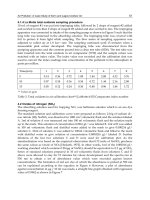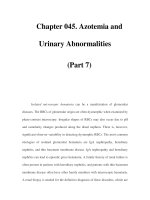Chapter 090. Bladder and Renal Cell Carcinomas (Part 7) pptx
Bạn đang xem bản rút gọn của tài liệu. Xem và tải ngay bản đầy đủ của tài liệu tại đây (42.22 KB, 6 trang )
Chapter 090. Bladder and Renal
Cell Carcinomas
(Part 7)
Renal Cell Carcinoma: Treatment
Localized Tumors
The standard management for stage I or II tumors and selected cases of
stage III disease is radical nephrectomy. This procedure involves en bloc removal
of Gerota's fascia and its contents, including the kidney, the ipsilateral adrenal
gland, and adjacent hilar lymph nodes. The role of a regional lymphadenectomy is
controversial. Extension into the renal vein or inferior vena cava (stage III disease)
does not preclude resection even if cardiopulmonary bypass is required. If the
tumor is resected, half of these patients have prolonged survival.
Nephron-sparing approaches via open or laparoscopic surgery may be
appropriate for patients who have only one kidney, depending on the size and
location of the lesion. A nephron-sparing approach can also be used for patients
with bilateral tumors, accompanied by a radical nephrectomy on the opposite side.
Partial nephrectomy techniques are being applied electively to resect small masses
for patients with a normal contralateral kidney. Adjuvant therapy following this
surgery does not improve outcome, even in cases with a poor prognosis.
Advanced Disease
Surgery has a limited role for patients with metastatic disease. However,
long-term survival may occur in patients who relapse after nephrectomy in a
solitary site that can be removed. One indication for nephrectomy with metastases
at initial presentation is to alleviate pain or hemorrhage of a primary tumor. Also,
a cytoreductive nephrectomy before systemic treatment improves survival for
carefully selected patients with stage IV tumors.
Metastatic renal cell carcinoma is highly refractory to chemotherapy and
only infrequently responsive to cytokine therapy with IL-2 or IFN-α. IFN-α and
IL-2 produce regressions in 10–20% of patients, but on occasion these responses
are durable. IL-2 was approved on the observation of durable complete remission
in a small proportion of cases.
The situation changed dramatically when two large-scale randomized trials
established a role for antiangiogenic therapy in this disease as predicted by the
genetic studies. These trials separately evaluated two orally administered
antiangiogenic agents, sorafenib and sunitinib, that inhibited receptor tyrosine
kinase signaling through the VEGF and PDGF receptors. Both showed efficacy as
second-line treatment following progression during cytokine treatment, resulting
in approval by regulatory authorities for the treatment of advanced renal cell
carcinoma. A randomized phase 3 trial comparing sunitinib to IFN-α showed
superior efficacy for sunitinib with an acceptable safety profile.
The trial resulted in a change in the standard first-line treatment from IFN
to sunitinib. Sunitinib is usually given orally at a dose of 50 mg/d for 4 weeks out
of 6. Diarrhea is the main toxicity. Sorafenib is usually given orally at a dose of
400 mg bid. In addition to diarrhea, toxicities include rash, fatigue, and hand-foot
syndrome. Temsirolimus, a mammalian target of rapamycin (mTOR) inhibitor,
also has activity in previously treated patients. The usual dosage is 25 mg IV
weekly.
The prognosis of metastatic renal cell carcinoma is variable. In one
analysis, no prior nephrectomy, a KPS <80, low hemoglobin, high corrected
calcium, and abnormal lactate dehydrogenase were poor prognostic factors.
Patients with zero, one or two, and three or more factors had a median survival of
24, 12, and 5 months, respectively. These tumors may follow an unpredictable and
protracted clinical course. It may be best to document progression before
considering systemic treatment.
Further Readings
Black PC et al: Molecular markers of urothelial cancer and their use in the
monitoring of superficial urothelial cancer. J Clin Oncol 24:5528, 2006 [P
MID:
17158538]
Brassell SA, Kamat AM: Contemporary intravesical treatment options for
urothelial carcinoma of the bladder. J Natl Compr Canc Netw 4:1027, 2006
[PMID: 17112451]
Cohen HT, McGovern FJ: Renal-
cell carcinoma. N Engl J Med 353:2477,
2005 [PMID: 16339096]
Huang WC et al: Chronic kidney disease after nephrectomy in patients with
renal cortical tumours: A retrospective cohort study. Lancet Oncol 7:735, 2006
[PMID: 16945768]
Mitra AP et al: Molecular pathways in invasive bladder cancer: New
i
nsights into mechanisms, progression, and target identification. J Clin Oncol
24:5552, 2006 [PMID: 17158541]
Motzer RJ et al: Sunitinib in patients with metastatic renal cell carcinoma.
JAMA 295:2516, 2006 [PMID: 16757724]
Nelson EC et al: Renal cell c
arcinoma: Current status and emerging
therapies. Cancer Treat Rev 33:299, 2007 [PMID: 17329029]
Sugano K, Kakizoe T: Genetic alterations in bladder cancer and their
clinical applicati
ons in molecular tumor staging. Nature Clin Pract 3:642, 2006
[PMID: 17149381]
Winquist E et al: Neoadjuvant chemotherapy for transitional cell carcinoma
of the bladder: A systematic review and meta-
analysis. J Urol 171:561, 2004
[PMID: 14713760]
Bibliography
Advanced Bladder Cancer Meta-
Analysis Collaboration: Neoadjuvant
chemotherapy in invasive bladder cancer: A systematic review and meta-
analysis.
Lancet 361:1927, 2003









